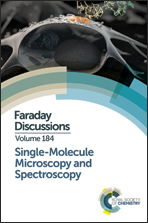Quantitative single molecule FRET efficiencies using TIRF microscopy
Abstract
Förster resonance energy transfer (FRET) microscopy at the single molecule level has the potential to yield information on intra and intermolecular distances within the 2–10 nm range of molecules or molecular complexes that undergo frequent conformation changes. A pre-requirement for obtaining accurate distance information is to determine quantitative instrument independent FRET efficiency values. Here, we applied and evaluated a procedure to determine quantitative FRET efficiencies directly from individual fluorescence time traces of surface immobilized DNA molecules without the need for external calibrants. To probe the robustness of the approach over a wide range of FRET efficiencies we used a set of doubly labelled double stranded DNA samples, where the acceptor position was varied systematically. Interestingly, we found that fluorescence contributions arising from direct acceptor excitation following donor excitation are intrinsically taken into account in these conditions as other correction factors can compensate for inaccurate values of these parameters. We give here guidelines, that can be used through tools within the iSMS software (http://www.isms.au.dk), for determining quantitative FRET and assess uncertainties linked with the procedure. Our results provide insights into the experimental parameters governing quantitative FRET determination, which is essential for obtaining accurate structural information from a wide range of biomolecules.
- This article is part of the themed collection: Single-Molecule Microscopy and Spectroscopy

 Please wait while we load your content...
Please wait while we load your content...